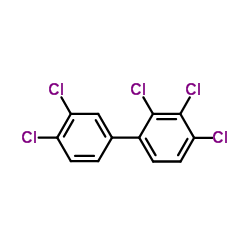PCB No 157(Aroclor 1254) solution

PCB No 157(Aroclor 1254) solution structure
|
Common Name | PCB No 157(Aroclor 1254) solution | ||
|---|---|---|---|---|
| CAS Number | 11097-69-1 | Molecular Weight | 326.433 | |
| Density | 1.5±0.1 g/cm3 | Boiling Point | 392.2±37.0 °C at 760 mmHg | |
| Molecular Formula | C12H5Cl5 | Melting Point | 95.86°C (estimate) | |
| MSDS | Chinese USA | Flash Point | 193.6±23.9 °C | |
| Symbol |




GHS02, GHS07, GHS08, GHS09 |
Signal Word | Danger | |
|
A novel toxicogenomics-based approach to categorize (non-)genotoxic carcinogens.
Arch. Toxicol. 89 , 2413-27, (2015) Alternative methods to detect non-genotoxic carcinogens are urgently needed, as this class of carcinogens goes undetected in the current testing strategy for carcinogenicity under REACH. A complicating factor is that non-genotoxic carcinogens act through seve... |
|
|
Enormous PCBs increase in oysters from the coast of Guangdong, China
Mar. Pollut. Bull. 62(6) , 1333-6, (2011) Highlights ► PCB concentrations (ngg−1 d.w.) ranged from 30 to 2040 with a mean of 315 in 2003–2007. ► Annual PCB levels were 313, 290, 342ngg−1 d.w., respectively in 2003, 2006, 2007. ► Recent PCB levels have risen by 350–1032 ratios compared with the data i... |
|
|
Transcriptome-wide gene expression in a rat model of attention deficit hyperactivity disorder symptoms: rats developmentally exposed to polychlorinated biphenyls.
Am. J. Med. Genet. B. Neuropsychiatr. Genet. 156B(8) , 898-912, (2011) Polychlorinated biphenyls (PCB) exposure in rodents provides a useful model for the symptoms of Attention deficit hyperactivity disorder (ADHD). The goal of this study is to identify genes whose expression levels are altered in response to PCB exposure. The b... |
|
|
Transferability of a modified embryonic stem cell test using a new endpoint for developmental neurotoxicity.
Toxicol. Mech. Methods 22(2) , 118-30, (2012) We developed and analyzed a new surrogate endpoint of the mouse embryonic stem cell test (EST) for developmental neurotoxicity. To determine the sensitivity, specificity, and transferability of the new endpoint, a pre-validation team from three independent la... |
|
|
Genotoxicity potential of a new natural formicide.
Environ. Sci. Pollut. Res. Int. 19(3) , 628-35, (2012) Assessment of environmental impacts from pesticide utilization should include genotoxicity studies, where the possible effects of mutagenic/genotoxic substances on individuals are assessed. In this study, the genotoxicity profile of the new formicide Macex® w... |
|
|
The toxic effects of Aroclor 1254 exposure on the osteoblastic cell line MC3T3-E1 and its molecular mechanism.
Toxicology 295(1-3) , 8-14, (2012) Polychlorinated biphenyls (PCBs) are still prevalent in the environment despite the fact that they have been banned in many countries for several decades. Recent epidemiologic studies have demonstrated a link between PCBs exposure and pathological alterations... |
|
|
Aroclor 1254 selectively inhibits expression of glial GLT-1 glutamate transporter in the forebrain of chronically exposed adult rat.
Toxicology 300(1-2) , 12-8, (2012) Aroclor 1254, a commercially produced mixture of polychlorinated biphenyls, is known to cause many adverse conditions, including neurotoxicity. It has been recently postulated that upregulation of N-methyl-d-aspartate receptors (NMDARs) and enhanced glutamate... |
|
|
Perinatal exposure to environmental polychlorinated biphenyls sensitizes hippocampus to excitotoxicity ex vivo
Neurotoxicology 32(6) , 981-5, (2011) Ortho-substituted polychlorinated biphenyls (PCBs) are a concern to human developmental health. Rat dams were exposed to an environmentally relevant mixture of PCBs, Aroclor 1254, or pure congener PCB 95 (6 mg/kg/day) during the perinatal period (GD 5 through... |
|
|
The metabonomics of combined dietary exposure to phthalates and polychlorinated biphenyls in mice
J. Pharm. Biomed. Anal. 66 , 287-97, (2012) Humans undergo simultaneous daily exposure to a multitude of endocrine-disrupting compounds (EDCs). In present study, after combined exposure to endocrine disruptors DEHP and Aroclor 1254 for 12 days, a liquid chromatography/time-of-flight mass spectrometer m... |
|
|
Enzyme-assisted synthesis of the glucuronide conjugate of psilocin, an hallucinogenic component of magic mushrooms.
Drug Test. Anal. 3(9) , 594-6, (2011) An enzyme-assisted synthesis of psilocin glucuronide (PCG), a metabolite excreted in the urine of magic mushroom (MM) users, is described. In the presence of Aroclor 1254 pretreated rat liver microsomes, psilocin and the cofactor UDPGA were incubated for 20 h... |